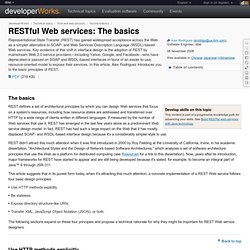

REST API Tutorial. Learn REST: A Tutorial. RESTful Web services: The basics. The basics REST defines a set of architectural principles by which you can design Web services that focus on a system's resources, including how resource states are addressed and transferred over HTTP by a wide range of clients written in different languages.

If measured by the number of Web services that use it, REST has emerged in the last few years alone as a predominant Web service design model. In fact, REST has had such a large impact on the Web that it has mostly displaced SOAP- and WSDL-based interface design because it's a considerably simpler style to use.
REST didn't attract this much attention when it was first introduced in 2000 by Roy Fielding at the University of California, Irvine, in his academic dissertation, "Architectural Styles and the Design of Network-based Software Architectures," which analyzes a set of software architecture principles that use the Web as a platform for distributed computing (see Resources for a link to this dissertation). Back to top Listing 1. Representational state transfer.
Representational State Transfer (REST) is a software architecture style consisting of guidelines and best practices for creating scalable web services.[1][2] REST is a coordinated set of constraints applied to the design of components in a distributed hypermedia system that can lead to a more performant and maintainable architecture.[3] REST has gained widespread acceptance across the Web[citation needed] as a simpler alternative to SOAP and WSDL-based Web services.

RESTful systems typically, but not always, communicate over the Hypertext Transfer Protocol with the same HTTP verbs (GET, POST, PUT, DELETE, etc.) used by web browsers to retrieve web pages and send data to remote servers.[3] The REST architectural style was developed by W3C Technical Architecture Group (TAG) in parallel with HTTP 1.1, based on the existing design of HTTP 1.0.[4] The World Wide Web represents the largest implementation of a system conforming to the REST architectural style. Architectural properties[edit] A Beginner's Guide to Water Cooling Your Computer. Have any of you guys tried water cooling?

This was my first go at it, and apart from a very stupid mistake that most people probably wouldn't make, it went very well—and was a lot easier than I thought (not to mention cheaper). My temps dropped nearly 10 degrees, and I'm going to hopefully try overclocking it even further when I get a chance. it looks like you did well, i personally have my video cards and CPU cooled with 2 triple radiators. its a little crazy another thing you can do with watercooling, is using compression fittings, they are quite a bit more expensive, upwards of 12 bucks a fitting but they are a lot more convenient when running tubing because of the fact that the way they work they will hold the tubing more securely leading to a safer watercooling experience, plus they look great omg I saw this yesterday soooo bad Yeah, I went with barbs and I'm not sad I did.
But compression fittings do definitely look better. Any reason you're selling the 560? Really! Hehe. Yup. SExpand. How Do The CPU and GPU Interact to Render Computer Graphics? Your computer’s Central Processing Unit (CPU) and Graphics Processing Unit (GPU) interact every moment you’re using your computer to deliver you a crisp and responsive visual interface.

Read on to better understand how they work together. Photo by sskennel. Today’s Question & Answer session comes to us courtesy of SuperUser—a subdivision of Stack Exchange, a community-drive grouping of Q&A web sites. The Question SuperUser reader Sathya posed the question: Here you can see a screenshot of a small C++ program called Triangle.exe with a rotating triangle based on the OpenGL API. Admittedly a very basic example but I think it’s applicable to other graphic cards operations. I was just curious and wanted to know the whole process from double clicking on Triangle.exe under Windows XP until I can see the triangle rotating on the monitor.
I guess involved in displaying this rotating triangle is primarily the following hardware/software among others: Hardware Software The Answer He writes: The Presentation.